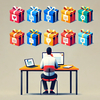
Technical writing has been around for a few centuries. It is a field that demands a specific set of skills for technical communicators to have. Throughout the centuries, technical writers served as mediators between people, who created technology and people who used technology. But where does technical writing come from? How old is it?
Antiquity
It all started in classical antiquity. The earliest examples of technical writing belong to Aristotle (384–322 BC). Archaeologists managed to retrieve short examples of his technical writings, including a dictionary of philosophic terms and a summary of the “Doctrines of Pythagoras”. Aristotle’s works are considered the earliest forms of technical writing.
Middle Ages
The first example of a technical document published in English was created by Geoffrey Chaucer (1343–1400). It was a scientific treatise on the astrolabe — a device used for measuring the distances of stars, planets etc. and for calculating the position of a ship. That work brought him fame during his lifetime as an author, philosopher and astronomer.

Renaissance
During the Renaissance, the theoretical knowledge of the Antiquity had been applied practically. Many inventions, including that of the mechanical printing press in the 15th century, created a need to chronicle new technologies. Famous inventors and scientists like Leonardo da Vinci (1452 – 1519) and Isaac Newton (1642–1727) compiled documents with their inventions and findings. Those documents played a crucial role in developing modern forms of technical writing and communication.
Age of Reason
More complex inventions had been made during the Industrial Revolution. However, at that time, only the inventors themselves knew how to use their new machines. The innovations waited to be tested and implemented into the daily life, but in order to do that people needed to learn how to use them. Unlike the past, when skills were handed down through oral traditions, the writers who could document these devices were desired.
XX Century

The golden age of technical writing began with World War I, when the nuclear technologies had been updated and the advances in medicine and aerospace technologies had been made. This rapid growth and the urgency of war created a need for documents that chronicled the use of these technologies.
After World War II, technological advances led to an increase in consumer goods and standards of living. During the post-war time libraries, universities and transport systems saw massive amounts of growth, and the need for writers to chronicle these processes increased.
The discovery of the transistor in 1947 allowed cheaper production of computers. Now individuals and small businesses could afford to buy them. As a result, the need for writers who could explain and document these devices grew.
The first known computational technical document was an instruction manual for the BINAC computer written by Joseph D. Chapline in 1949.
In 1953, two organizations were founded: the Society of Technical Writers and the Association of Technical Writers and Editors. Today they are known as Society for Technical Communication (STC).
1960s saw the growth of technology, particularly in the electronics, aeronautics, and space industries. 1970s and 1980s were marked by the expansion of the consumer electronics into people’s lives. These were the decades when the demand for technical writers was skyrocketing.
In 1976 the Modern Language Association (MLA) approved a panel on technical writing at its annual conference. And in 1980 the U.S. Department of Justice announced technical writing a profession.
In 1980s PCs arrived in the workplace, accompanied by large manuals with names such as “Guide to Operation”.
XXI Century

In 2000s how-to books and guides increased in popularity. And in 2010s applications and programs included tooltips and product tours, and web help became even more sophisticated.
Nowadays technical documentation is required in every field, from construction to food processing and preservation. Software documentation and user guides are considered a must for any application or software. If you are particularly good at plain writing, you have good research and exploration skills as well as other traits of a good technical writer, you should definitely consider becoming a technical writer.
Good Luck with your technical writing!
ClickHelp Team
Online Technical Writing & Documentation Tools


